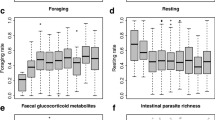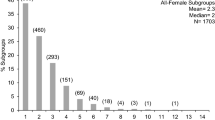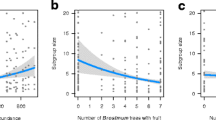Abstract
Seasonal patterns of group fragmentation, including the size of subgroups and percentage of time spent in subgroups, may provide information on individual decision-making in response to resource distribution. Age-sex class composition of subgroup membership can offer insights into the social dynamics of the group as a whole. At most field sites, capuchins (Cebus spp.) form stable groups with no evidence of group fragmentation. Here I describe seasonal subgrouping patterns, including proportion of time spent in subgroups, subgroup size, age-sex membership, dyadic fidelity, stability of membership, and the effect of subgrouping on individual foraging efficiency, in a group of wild Cebus apella nigritus. From September 1996 to August 1997 the study group at the Estação Biológica de Caratinga, Brazil divided into 148 different subgroups, on 99 of 194 census days. In contrast to expectations for subgrouping patterns as a response to seasonal distribution of resources, the proportion of days spent in subgroups did not vary significantly by season. Subgroup composition was relatively fluid, with multimale multifemale subgroups the most common throughout the year. Unimale multifemale subgroups were restricted to the wet season; in contrast, all-male subgroups and unimale unifemale subgroups occurred in the dry season. For both males and females, low rank predicted membership in smaller subgroups. For males, but not females, subgrouping coincided with increased foraging efficiency, as measured by increased time spent ingesting food and decreased time spent traveling on days with subgrouping compared to days with the group in a cohesive unit.






Similar content being viewed by others
References
Altmann, J. (1974a). Observational study of behavior: Sampling methods. Behaviour, 49, 227–267.
Altmann, S. (1974b). Baboons, space, time, and energy. American Zoologist, 14, 221–248.
Baldwin, J. D., & Baldwin, J. I. (1981). The squirrel monkeys, genus Saimiri. In A. F. Coimbra-Filho & R. A. Mittermeier (Eds.), Ecology and behavior of neotropical primates I (pp. 277–330). Rio de Janeiro: Academia Brasileira de Ciências.
Boinski, S. (2000). Social manipulation within and between troops mediates primate group movement. In S. Boinski & P. A. Garber (Eds.), On the move: How and why animals travel in groups (pp. 421–446). Chicago: University of Chicago Press.
Boubli, J. P. (1999). Feeding ecology of black-headed uacaris (Cacajao melanocephalus melanocephalus) in Pico da Neblina National Park, Brazil. International Journal of Primatology, 20, 719–749.
Chapman, C. A. (1988). Patch use and patch depletion by the spider and howling monkeys of Santa Rosa National Park, Costa Rica. Behaviour, 105, 99–116.
Chapman, C. A. (1990). Association patterns of spider monkeys: The influence of ecology and sex on social organization. Behavioral Ecology and Sociobiology, 26, 409–414.
Chapman, C. A., Wrangham, R. W., & Chapman, L. J. (1995). Ecological constraints on group size: An analysis of spider monkey and chimpanzee subgroups. Behavioral Ecology and Sociobiology, 36, 59–70.
Chepko-Sade, B. D., & Sade, D. S. (1979). Patterns of group splitting within matrilineal kinship groups: A study of social group structure in Macaca mulatta (Cercopithecidae: Primates). Behavioral Ecology and Sociobiology, 5, 67–87.
Defler, T. R. (1999). Fission-fusion in the black-headed uacari (Cacajao melanocephalus) in eastern Colombia. Neotropical Primates, 7, 5–8.
Di Bitetti, M. (1997). Evidence for an important social role of allogrooming in a platyrrhine primate. Animal Behavior, 54, 199–211.
Di Bitetti, M. S., & Janson, C. H. (2000). When will the stork arrive? Patterns of birth seasonality in Neotropical primates. American Journal of Primatology, 50, 109–130.
Di Bitetti, M. S., & Janson, C. H. (2001). Reproductive socioecology of tufted capuchins (Cebus apella nigritus) in northeastern Argentina. International Journal of Primatology, 22, 127–142.
Dittus, W. P. J. (1988). Group fission among wild toque macaques as a consequence of female resource competition and environmental stress. Animal Behaviour, 36, 1626–1645.
Fedigan, L. M., Rose, L. M., & Avila, R. M. (1996). See how they grow, tracking capuchin monkey (Cebus capucinus) populations in regenerating Costa Rican dry forest. In M. A. Norconk, A. L. Rosenberger, & P. A. Garber (Eds.), Adaptative radiations of neotropical primates (pp. 289–307). New York: Plenum Press.
Ferrari, S. F. (1988). The behaviour and ecology of buffy-headed marmoset, Callithrix flaviceps (O Thomas, 1903). PhD Thesis, University College London.
Fukuda, F. (1989). Habitual fission-fusion and social organization of the Hakone troop T of Japanese macaques in Kanagawa Prefecture, Japan. International Journal of Primatology, 10, 419–439.
Guimarães, A. (1998). Ecology and social behavior of buffy headed marmosets, Callithrix flaviceps. Neotropical Primates, 6, 51–52.
Izar, P. (2003). Female social relationships of Cebus apella nigritus in a Southeastern Atlantic forest: An analysis through ecological models of primate social evolution. Behaviour, 141, 71–99.
Izawa, K. (1976). Group sizes and compositions of monkeys in the Upper Amazon Basin. Primates, 17, 367–399.
Izawa, K. (1980). Social behavior of the wild black-capped capuchin (Cebus apella). Primates, 21, 443–467.
Izawa, K. (1990). Social changes within a group of wild black-capped capuchins (Cebus apella) in Colombia (II). Field studies of New World Monkeys, La Macarena Colombia. Japan and Colombia Cooperative Study of Primates, Vol 3, pp. 1–6.
Izawa, K. (1992). Social changes within a group of wild black-capped capuchins (Cebus apella) (III). Field studies of New World Monkeys, La Macarena, Colombia, Vol. 7, pp. 9–14.
Izawa, K. (1994a). Group division of wild black-capped capuchins. Field Studies of New World Monkeys, La Macarena, Colombia, Vol. 9, pp. 5–14.
Izawa, K. (1994b). Social changes within a group of wild black-capped capuchins (IV). Field studies of New World Monkeys, La Macarena Colombia, Vol. 9, pp. 15–21.
Izawa, K. (1997). Social changes within a group of wild black-capped capuchins V. Field studies of New World Monkeys, La Macarena Colombia, Vol. 11, pp. 1–10.
Jack, K., & Fedigan, L. (2004a). Male dispersal patterns in white-faced capuchins, Cebus capucinus Part 1: Patterns and causes of natal emigration. Animal Behaviour, 67, 761–769.
Jack, K., & Fedigan, L. (2004b). Male dispersal patterns in white-faced capuchins, Cebus capucinus. Part 2: Patterns and causes of secondary dispersal. Animal Behaviour, 67, 771–782.
Janson, C. H. (1984). Female choice and mating system of brown capuchin monkey Cebus apella (Primates: Cebidae). Zeitshrift für Tierpschychologie, 65, 177–200.
Janson, C. (1986). The mating system as a determinant of social evolution in capuchin monkeys (Cebus). In J. G. Else & P. C. Lee (Eds.), Primate ecology and conservation. New York: Cambridge University Press.
Jolly, A. (1972). Troop continuity and troop spacing in Propithecus verreauxi and Lemur catta at Berenty (Madagascar). Folia Primatologica, 17, 335–362.
Jones, C. B. (1995). Howler subgroups as homeostatic mechanisms in disturbed habitats. Neotropical Primates, 3, 7–9.
Kinzey, W. G., & Cunningham, E. P. (1994). Variability in Platyrrhine social organization. American Journal of Primatology, 34, 185–198.
Koyama, N. (1970). Changes in dominance rank and division of a wild Japanese monkey troop in Arashiyama. Primates, 11, 335–390.
Kummer, H. (1968). Social organization of hamadryas baboons. A field study. Bibliotheca Primatologica, 6, 1–189.
Lynch, J. W. (2001). Male behavior and endocrinology in wild tufted capuchin monkeys, Cebus apella nigritus. Ph.D. dissertation, University of Wisconsin-Madison.
Lynch Alfaro, J. W. (2005). Male mating strategies and reproductive constraints in wild tufted capuchin monkeys, Cebus apella nigritus. American Journal of Primatology, 67, 313–328.
Lynch, J. W., & Rímoli, J. (2000). Demography of a group of tufted capuchin monkeys (Cebus apella nigritus) at the Estação Biológica de Caratinga, Minas Gerais, Brazil. Neotropical Primates, 8, 44–49.
Lynch, J. W., Ziegler, T. E., & Strier, K. B. (2002). Individual and seasonal variation in fecal testosterone and cortisol in wild male tufted capuchin monkeys, Cebus apella nigritus. Hormones and Behavior, 41, 275–287.
Malik, I., Seth, P. K., & Southwick, C. H. (1985). Group fission in free-ranging rhesus monkeys of Tughlaqabad, Northern India. International Journal of Primatology, 6, 411–422.
Martin, R. D. (1972). A preliminary field-study of the lesser mouse lemur (Microcebus murinus J. F. Miller 1777). Forschitte der Verhaltensforschung, 9, 43–89.
Martin, R. D. (1973) A review of the behaviour and ecology of the lesser mouse lemur (Microcebus murinus J. F. Miller 1777). In R. P. Michael & J. H. Crook (Eds.), Comparative ecology and behaviour of primates (pp. 1–6). New York: AcademicPress.
Matheson, M. D., Johnson, J. S., & Feuerstein, J. (1996). Male reunion displays in tufted capuchin monkeys (Cebus apella). American Journal of Primatology, 40, 183–188.
Matsumoto-Oda, A., Hosaka, K., Huffman, M. A., & Kawanaka, K. (1998). Factors affecting party size in chimpanzees of the Mahale mountains. International Journal of Primatology, 19, 999–1011.
Mendes, S. L. (1989). Estudo ecológico de Alouatta fusca (Primates: Cebidae) na Estação Biológica de Caratinga, MG. Revista Nordestina de Biologia, 6, 71–104.
Miller, L. E. (1996). The behavioral ecology of wedge-capped capuchin monkeys (Cebus olivaceus). In M. A. Norconk, A. L. Rosenberger, & P. A. Garber (Eds.), Adaptive radiations of neotropical primates (pp. 271–288). New York: Plenum Press.
Milton, K. (1984). Habitat, diet and activity pattern of free-ranging woolly spider monkeys (Brachyteles arachnoides E. Geoffroy 1808). International Journal of Primatology, 5, 491–514.
Morland, H. S. (1991) Preliminary report on the social organization of ruffed lemurs (Varecia variegata variegata) in a northeast Madagascar rain forest. Folia Primatologica, 56, 157–161.
Nishida, T., & Hiraiwa-Hasegawa, M. (1987). Chimpanzees and bonobos: Cooperative relationships among males. In B. Smuts, D. Cheney, R. Seyfarth, R. Wrangham, & T. Struhsaker (Eds.), Primate societies (pp. 165–180). Chicago: University of Chicago Press.
Panger, M. A. (1997). Hand preference and object-use in free-ranging white faced capuchin monkeys (Cebus capucinus) in Costa Rica. Ph.D. dissertation. University of California, Berkeley.
Perry, S. (1995). Social Relationships in Wild White-Faced Capuchin Monkeys, Cebus capucinus. Ph.D. dissertation, UMI.
Perry, S. (1996a). Female-female social relationships in wild white-faced capuchin monkeys (Cebus capucinus). American Journal of Primatology, 40, 167–182.
Perry, S. (1996b). Intergroup encounters in wild white-faced capuchins (Cebus capucinus). International Journal of Primatology, 17, 309–330.
Philips, K. A., & Shauver Goodchild, L. M. (2005). Reunion displays in captive male brown capuchins (Cebus apella). Primates, 46, 121–125.
Rigamonti, M. M. (1993). Home range and diet in red ruffed lemurs (Varecia variegata rubra). on the Masoala Peninsula, Madagascar. In P. M. Kappeler & J. U. Ganzhorn (Eds.), Lemur social systems and their ecological basis (pp. 25–39). New York: Plenum Press.
Rímoli, J. (2001). Ecologia de macacos-pregos (Cebus apella nigritus, Goldfuss, 1809, Primates, Cebidae) na Estação Biológica de Caratinga (MG): implicações para a conservação de fragmentos de Mata Atlântica. Ph.D. dissertation. Centro de Ciência Biológicas, Universidade Federal do Pará.
Rímoli, J., & Ferrari, S. (1997). Comportamento e ecologia de macacos-prego (Cebus apella nigritus, GOLDFUSS 1809) na Estação Biológica de Caratinga (MG). Programa e Resumos, VIII Congresso Brasileiro de Primatologia. João Pessoa, PB, Brasil, p. 231.
Robinson, J. G. (1988a). Demography and group structure in wedge-capped capuchin monkeys, Cebus olivaceus. Behaviour, 104, 202–232.
Robinson, J. G. (1988b). Group size in wedge-capped capuchin monkeys Cebus olivaceus and the reproductive success of males and females. Behavioral Ecology and Sociobiology, 23, 187–197.
Robinson, J. G., & Janson, C. H. (1987). Capuchins, squirrel monkeys, and atelines: Socioecological convergence with Old World Primates. In B. Smuts, D. Cheney, R. Seyfarth, R. Wrangham, & T. Struhsaker (Eds.), Primate societies (pp. 69–82). Chicago: University of Chicago Press.
Soini, P. (1986). A synecological study of a primate community in the Pacaya-Samiria national Reserve, Peru. Primate Conservation, 7, 63–71.
Strier, K. B. (1992). Faces in the forest: The endangered Muriqui monkeys of Brazil. New York: Oxford University Press.
Strier, K. B., Mendes, S. L, Bragança, A. M., Coelho, C. C., Costa, C. G., Diaz, L. G., et al. (1999). Census of the primate community at the Estação Biológica de Caratinga, Minas Gerais, Brazil. Neotropical Primates, 7, 134–135.
Strier, K. B., Mendes, F. D. C., Rímoli, J., & Rímoli, A. O. (1993). Demography and social structure of one group of muriquis (Brachyteles arachnoides). International Journal Primatology, 14, 513–526.
Strier, K. B., Mendes, S. L., & Santos, R. R. (2001). The timing of births in sympatric brown howler monkeys (Alouatta fusca clamitans) and northern muriquis (Brachyteles arachnoides hypoxanthus). American Journal Primatology, 55, 87–100.
Strier, K. B., Ziegler, T. E., & Wittwer, D. J. (1999). Seasonal and social correlates of fecal testosterone and cortisol levels in wild male muriquis (Brachyteles arachnoides). Hormones and Behaviour, 35, 125–134.
Symington, M. M. (1990). Fission-fusion social organization in Ateles and Pan. International Journal of Primatology, 11, 47–61.
Tattersall, I. (1982). The primates of Madagascar. Press, New York: Columbia University.
van Noordwijk, M. A., & van Schaik, C. P. (1987). Competition among female long-tailed macaques, Macaca fascicularis. Animal Behavior, 35, 577–589.
van Schaik, C. P., van Noordwijk, M. A., de Boer, R. J., & den Tonkelaar, I. (1983). The effect of group size on time budgets and social behaviour in wild long-tailed macaques (Macaca fascicularis). Behavioral Ecology and Sociobiology, 13, 173–181.
White, F. J. (1991) Social organization, feeding ecology, and reproductive strategy of ruffed lemurs, Varecia variegata. In A. Ehara, T. Kimura, O. Takenaka, & M. Iwamonto (Eds.), Primatology today (pp. 81–84). Amsterdam: Elsevier.
White, F. J., & Wrangham, R. W. (1988) Feeding competition and patch size in the chimpanzee species Pan paniscus and Pan troglodytes. Behaviour, 105, 148–164.
Wrangham, R. W. (1980). An ecological model of female-bonded primate groups. Behaviour, 75, 262–300.
Wrangham, R. W., & Smuts, V. V. (1980). Sex differences in the behavioural ecology of chimpanzees in the Gombe National Park, Tanzania. Journal of Reproduction and Fertility, 28, 13–31.
Acknowledgments
I thank Karen B. Strier (University of Wisconsin-Madison), José Rímoli (Universidade Católica Dom Bosco), David Morales Torres (Universidad Veracruzana), Sérgio Lucena Mendes (Museo de Biologia Mello Leitão), and Michael Edward Alfaro (Washington State University). Alice Guimarães, Andreia Silene Oliva, Laiena Texeira Dib, Rogério Ribeiro dos Santos, Jairo Gomes, Eduardo Veado, and the EBC staff made work at Caratinga a pleasure. This research was supported by grants from Fulbright/IIE, Wenner-Gren Foundation (Predoctoral Grant 6068), Tinker Foundation/Nave Fund, and a National Science Foundation Graduate Fellowship.
Author information
Authors and Affiliations
Corresponding author
Rights and permissions
About this article
Cite this article
Lynch Alfaro, J.W. Subgrouping Patterns in a Group of Wild Cebus apella nigritus . Int J Primatol 28, 271–289 (2007). https://doi.org/10.1007/s10764-007-9121-0
Received:
Revised:
Accepted:
Published:
Issue Date:
DOI: https://doi.org/10.1007/s10764-007-9121-0




